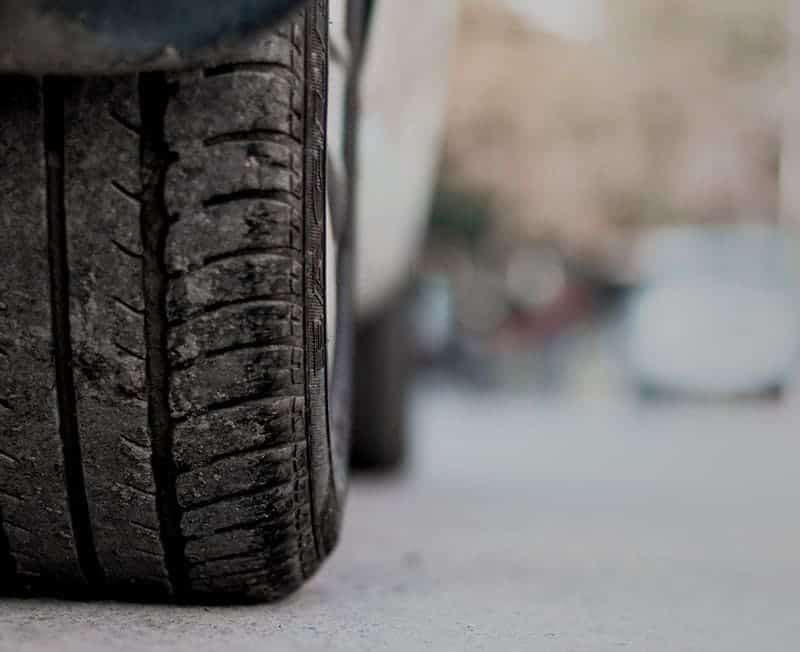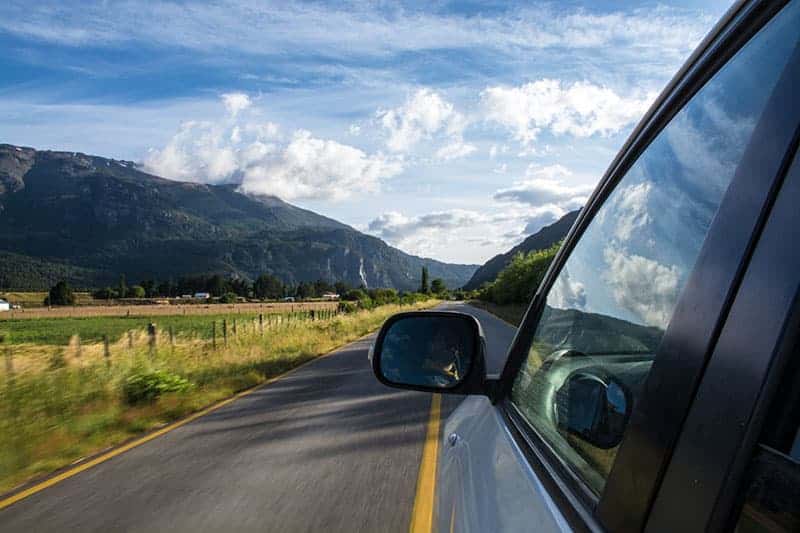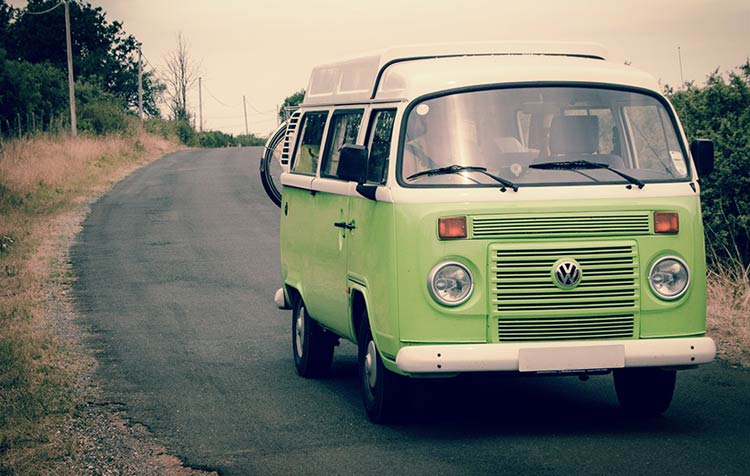Kann man eigentlich klimafreundlich, ressourcenschonend und nachhaltig Autofahren? Und falls ja: Wie? Wenn du Antworten auf diese Fragen suchst, bist du hier genau richtig! Es ist völlig klar, dass es umweltfreundlichere Verkehrsmittel gibt, als Diesel und Benziner – zum Beispiel das Bike. Nevertheless, in the sense of the sustainable life of course, many ideas, tips & tricks to make the journey with your car as sustainable as possible.
In this article, I'll show you the best tips for more climate-friendly, environmentally conscious and sustainable car trips in the future. Let's go!
Why drive sustainably at all?
About 46 million diesel and gasoline engines already claim the German roads₁, hitting an average of 139 grams greenhouse gases per passenger kilometer₂ driven. In addition, there is also the CO2-emissions that the extraction of the fuel entails - this is not usually taken into account in the discussion of environmental compatibility. In any case, these facts underscore the fact that our transport sector was responsible for 18% of greenhouse gas emissions in Germany in 2016.₃ This means that driving has a very decisive share of the climate change.
The traffic turnaround is already underway - albeit at a slower pace. Today, at least 83,175 electric cars₄ are already creeping along Germany's roads with zero emissions, only emitting CO2 emissions. But even without an electric car, you can be as sustainable as possible with your car.
20 Tipps: Wie kann man umweltfreundlicher Autofahren?

There are drivers who use their cars in a sustainable manner and those whose behavior has the exact opposite effect. Sustainable driving does not just mean using a car that is environmentally friendly driving behavior to the day. You can lay the foundation for more sustainability when buying a car or through maintenance, check-ups or the weight transported.
In the following, I will give you the decisive tips.
1. buy eco friendly car
Every car model has a different level of sustainability. That's why you have a great opportunity to make your future car journeys as environmentally friendly as possible right from the moment of purchase. Pay particular attention to ensuring that your vehicle emits as little CO2 emitted. Every year, Verkehrsclub Deutschland e.V. publishes the VCD environmental list with the most sustainable cars out. Here you can simply look directly.
Inspiration: Maybe you don't need a car at all, like me? In a city like Berlin, there are many alternatives, including cycling, public transport, walking and car sharing. Just read the article about the car free life inspire a little bit.
2. buy used car
The smell of a new car is wonderful - but a used car does not have to be produced especially for you and saves natural resources as well as your wallet. In the best case, you can even save a somewhat damaged car. repair or restore. However, you also have to make sure that the car emits as little CO2 into the atmosphere - otherwise your used car would unfortunately only be sustainable in the short term.
3. buy a car that suits its purpose
Do you only need your car to drive to your parents' home alone from time to time? Then a smaller, fuel-efficient car is perfectly adequate. Before you buy a car, make a few Thinking about what purpose it will serve in the short term as well as the long term. Do you really need a swanky car just to show off to others? Probably not. In terms of sustainability, a more environmentally friendly and less expensive small car will do in most cases.
4. avoid driving and use alternatives
Whenever you can, you should aim for more sustainable Alternative to driving a car change. In the big city, public transportation and, above all, bicycles are available. Not only is it more sustainable, it's also much faster than driving. In the countryside, there are also buses that take you from A to B. It's not always convenient - but certainly more often than you think.
But above all, avoid traveling short distances by car. For example, if you want to pick up fresh rolls from the bakery or drop off a package at the post office. No one wants to be stuck in traffic jams either. For longer journeys, be sure to check the route conditions - because most of the time you'll reach your destination faster and more comfortably by train.
5. reduce weight of the car
It's best to make sure that your car has the lowest possible curb weight when you buy it. After that, you no longer have any influence on it. But you do have an influence on the actual driving weight. Everyone knows someone whose car looks like a miniature garbage dump. Everything imaginable is lying around there and is chauffeured over Germany's roads every day. The lower the additional weight of your car, the more sustainable you are on the road. This goes from your personal weight to the items in your car. Just make sure that your car Drive around as little ballast as possible must.
6. do not give full throttle
Driving at full throttle to achieve the traffic turnaround? Sure! Driving a car at full throttle? Better not. On the one hand because the danger for you and others is very high, on the other hand because the Fuel consumption of your car many times higher is. The standard values of a vehicle's fuel consumption are set under ideal conditions and speeds below 120 km/h for a reason.₅ Therefore, prefer a steady, appropriate pace rather than pushing the accelerator pedal to the metal.
7. car off at standstill
Even when idling, a car consumes an average of about 0.8 - 1.2 liters of fuel - did you know that? With automatic start-stop, it's worth switching off from the very first second. But with other cars, it's also worth it after about 5 to 10 seconds.₆
Whether opening the garage door, disposing of waste at the glass container or at the railroad crossing -. always turn off your car if you are going to stand for more than 10 seconds.
8. shift up early enough
For the most sustainable car ride possible, you should Shift to the next gear early and at low speeds drive. This saves fuel and is easy on your wallet. For example, shift into third gear at 30 km/h and into fourth gear at 50-60 km/h. An environmentally friendly speed is around 2,000 revolutions. So always drive at as low a speed as possible and also drive at a steady speed.
9. check the tire pressure of the car regularly

When you're riding your bike, have you ever noticed how tiring it suddenly is when your tire is not so well inflated? Your car feels the same way when your tires are underinflated. Even 0.5 bar too little can increase your fuel consumption by a whole liter per 100 kilometers.₇ For sustainable use of your car, you should therefore regularly check and optimize your tire pressure. To find out,
Tip: You can find the ideal tire pressure for your car in the owner's manual or on a sticker on the side of the car or in the lid of the glove compartment.
10. anticipatory driving with the car
Even in road traffic, it is important to think ahead. On the one hand, this will give you and other road users more Security. But especially you also reduce fuel consumption of your car. Ensure that you have to brake and restart as little as possible by driving with foresight. For example, if you see a red light, you can use the automatic engine brake instead of going full throttle. Compared to idling, this consumes no fuel at all.
11. low-viscosity oils and low-viscosity tires
The Federal Environment Agency recommends that all drivers use low-friction oils and low-friction tires to further reduce the fuel consumption of their cars. The low-viscosity oil reduces frictional resistance in the engine, for example. It is slightly more expensive than conventional engine oil, but it brings fuel cost savings. The low rolling resistance tires reduce rolling resistance, so your car uses less fuel. According to the German Federal Environment Agency, this makes the car run much more smoothly. quieter and consumes up to 6% less fuel.₈
12. clean air filter regularly
A dirty air filter will cause your car to consume more fuel. Through a Regular cleaning you are simply helping to make your car journeys even more environmentally friendly.
Coarser dirt such as leaves and insects must be removed in the same way as fine particles that are barely visible. After tapping, you should therefore also thoroughly vacuum the air filter again. Incidentally, this extends the service life of the filter by two to three times.₉
13. parking suitable to the outside temperature
On hot summer days For example, you should deliberately park in the shade so that your car is nice and cool when you get back in. This also automatically prevents fuel evaporation due to solar radiation. Make sure that the shade remains even as the sun moves throughout the day. This will save you the use of energy-intensive air conditioning later on.
In winter you should definitely park in the garage, so that your car is protected from frost and requires as little energy and fuel as possible to get warm.
14. window pane down instead of air conditioner
Your car's air conditioning system is a real power and fuel guzzler. If you want to drive in the most environmentally friendly way possible, you should instead use the free ride wind with open window. Within a short time it is nice and cool again. If your air conditioner had to do this job, it would be very costly. The less the air conditioner has to work, the more sustainable you are on the road.
15. reduce power guzzlers in the car
The air conditioning system can increase fuel consumption in city traffic by up to 30%.₁₀ In addition to the Air conditioner But if possible, you should also switch off all other power guzzlers in your car. Alternator, radio or rear window heater are very good examples of this. Especially the latter is often and unnecessarily switched on.
16. do not use heating if possible
Both your car's built-in heater and a mobile heater fan - powered by the cigarette lighter - should be left switched off if possible. In the summer, you don't need the heater anyway and in winter you can, for example, get a mat for your windshield or park directly in the garage or parking garage. This way you protect your car from high energy consumption to defrost the windshield. And you yourself will have to scratch less often.
17. carpooling
Do you have to drive to work every day because there is simply no alternative? Often colleagues come from the same area and take similar routes every day. Just check your company intranet to see if anyone else comes from that direction. Often, some ideas for carpooling arise from personal conversations. This make many car journeys permanently superfluous and bring colleagues together even more. But carpooling also makes a lot of sense outside of work - for example, at regular sporting events with the soccer club.
18. use and offer carpooling
Nowadays, there are many carpooling portals where you can use or offer rides yourself. This saves a lot of money and hundreds of unnecessary car trips just for you personally. For example, you can get from Berlin to Essen for 21€ with a perfectly rated and experienced driver who offers his ride at BlaBlaCar advertised. This is not only more sprint-saving, but also much cheaper than driving yourself alone. If you have to drive a longer distance yourself for some reason, you can offer this ride online and receive this amount from others for giving you a ride.
Whether as a passenger or driver - in addition to wonderful benefits for our environment, this also creates real friendships.
19. borrow or lend and share car
Yes, that is also possible. These days, sharing is back in a big way - especially in the big cities, you can share with the Car-Sharing rent a car simply when needed - whether for moving furniture or for a trip to a swimming lake in the area.
But also privately you can make your car available to other, legitimate people and earn some money with it. After all, a car that is used by several people saves natural resources by making a new purchase unnecessary. In addition, more space is created in cities, since cars spend most of their lives in parking lots.
20. have car checked regularly
Of course, no one wants expensive and constant checks and checkups. But it makes sense to keep your car running for as long as possible, with little loss of value and, above all, with low fuel consumption and a high level of safety. For a long-lasting and sustainable car, your car should therefore be checked regularly. Have it checked by a professional. The check is usually very cheap and after that you can always decide with which repairs your money is well spent.
Nachhaltig Autofahren – geht das also?

Yes, it is possible. Sustainable driving is also possible. In this article, you've learned the most important tips for driving sustainably and keeping your car as environmentally friendly as possible. And you don't even have to implement all the tips at the same time. Instead, you can always fall back on them when they present themselves.
"Paths are made by walking them."
Erich Kästner (more under Mobility Quotes)
Do you have any suggestions, questions, or your own experiences with sustainable driving that you'd like to share? Then feel free to leave a comment below this post.
Bleib‘ nachhaltig und gute Fahrt,

PS: Schau dich gerne noch ein bisschen im Blog for sustainable living around and learn for example, how sustainable e-scooters really are.
References:
₁ Umweltbundesamt (2017): Bus und Bahn fahren (as at: 24.08.2017). https://www.umweltbundesamt.de/umwelttipps-fuer-den-alltag/mobilitaet/bus-bahn-fahren. [09.08.2019].
₂ TREMOD 5.82; Federal Environment Agency (2017): Comparison of average emissions of individual road users in passenger transport (as of 13.11.2018).
₃ Umweltbundesamt (2016): Emissionsquellen (Stand: 10.01.2016). https://www.umweltbundesamt.de/themen/klima-energie/treibhausgas-emissionen/emissionsquellen. [25.08.2019].
₄ Henßler, S.: Myths and facts about e-cars (05.05.2019). https://www.elektroauto-news.net/2019/folge-023-mythen-fakten-e-autos. [09.08.2019].
₅ Axel Springer SE (2014): Extreme test: What does full throttle cost? (As of: 07.01.2014). https://www.autobild.de/artikel/zehn-autos-im-vollgas-test-4511490.html. [25.08.2019].
₆ Quality Alliance Eco-Drive: Switch off the motor when stopped. https://www.ecodrive.ch/de/tipps/pw/fahrweise-optimieren/12-halten-motor-abschalten. [25.08.2019].
₇ AutoScout24 GmbH (2018): Air pressure for tires - consumption and wear (as at: 05.12.2018). https://www.autoscout24.de/informieren/ratgeber/kfz-technik/luftdruck-bei-reifen-verbrauch-und-verschleiss. [25.08.2019].
₈ Umweltbundesamt (2013): Verwenden Sie Leichtlauföle und Leichtlaufreifen (Stand: 24.06.2013). https://www.umweltbundesamt.de/tipp/verwenden-sie-leichtlaufoele-leichtlaufreifen. [25.08.2019].
₉ Konzept Steinheimer Beratungsgesellschaft UG (2017): Mit Luftfilter Sprit sparen (Status: 16.11.2017). https://benzinampel.de/blog/spartipps/luftfilter-sprit-sparen.html. [25.08.2019].
₁₀ German Council for Sustainable Development (RNE): Climate-conscious driving. https://www.nachhaltiger-warenkorb.de/themen/klimabewusst-autofahren. [25.08.2019].









Very worth reading article! In driving school, important tips for sustainable driving are also mentioned again and again. Should definitely take to heart. Many greetings
Thank you for these tips on how I can drive more sustainably. I did hear in driving school that I should drive with as much foresight as possible, but I still find that relatively difficult. But in the future, I will try to use the engine brake more at red lights, for example, instead of the normal brake. That way, I'll even save on gasoline.
This is very helpful info! That's a good idea to buy an environmentally friendly used car. I will definitely forward the article to my girlfriend. I'm sure she will find this very interesting as well, since her daughter will soon be learning to drive.
Hi Katherine! Thanks for your feedback - feel free to pass on the tips 🙂 .
Many greetings and a good trip at all times,
Christoph
Comments are closed.